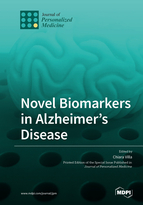Novel Biomarkers in Alzheimer’s Disease
A special issue of Journal of Personalized Medicine (ISSN 2075-4426). This special issue belongs to the section "Omics/Informatics".
Deadline for manuscript submissions: closed (5 July 2020) | Viewed by 129614
Special Issue Editor
Interests: genetics; Alzheimer’s disease; non-coding RNAs; neurodegeneration; epilepsy; brain; biomarkers
Special Issues, Collections and Topics in MDPI journals
Special Issue Information
Dear Colleagues,
Alzheimer’s disease (AD) is the most common form of dementia in the elderly, affecting about 46 million people worldwide. It is clinically characterized by the progressive deterioration of memory and other cognitive functions that results in the loss of autonomy and which ultimately requires full-time medical care. The diagnosis of AD currently relies on clinical criteria, including mental status assessment, neurological examination, and brain imaging tests. However, these imaging methods are conclusive only in the advanced stages of disease, whereas AD physiopathology begins several decades before onset of the first symptoms. It is therefore particularly important to identify potential biomarkers that can be used in the early detection of AD, i.e., before clinical signs appear, as well as to evaluate the efficiency of therapeutic agents under testing and to thus accelerate the therapeutic discovery process. In this Special Issue, the current knowledge as well as future perspectives on the role of biomarkers in screening, diagnosis, treatment and follow-up of Alzheimer’s disease will be discussed.
Dr. Chiara VillaGuest Editor
Manuscript Submission Information
Manuscripts should be submitted online at www.mdpi.com by registering and logging in to this website. Once you are registered, click here to go to the submission form. Manuscripts can be submitted until the deadline. All submissions that pass pre-check are peer-reviewed. Accepted papers will be published continuously in the journal (as soon as accepted) and will be listed together on the special issue website. Research articles, review articles as well as short communications are invited. For planned papers, a title and short abstract (about 100 words) can be sent to the Editorial Office for announcement on this website.
Submitted manuscripts should not have been published previously, nor be under consideration for publication elsewhere (except conference proceedings papers). All manuscripts are thoroughly refereed through a single-blind peer-review process. A guide for authors and other relevant information for submission of manuscripts is available on the Instructions for Authors page. Journal of Personalized Medicine is an international peer-reviewed open access monthly journal published by MDPI.
Please visit the Instructions for Authors page before submitting a manuscript. The Article Processing Charge (APC) for publication in this open access journal is 2600 CHF (Swiss Francs). Submitted papers should be well formatted and use good English. Authors may use MDPI's English editing service prior to publication or during author revisions.
Keywords
- biomarkers
- Alzheimer’s disease
- dementia
- neurodegeneration
- brain
- genetics







